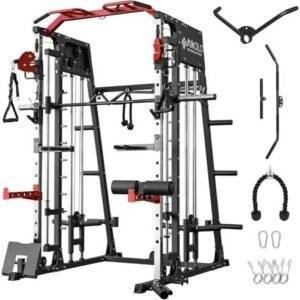Powerlifting is a popular strength sport that focuses on three main lifts: the squat, the bench press, and the deadlift. It emphasizes building overall strength and mastering proper techniques for each exercise. Whether you’re a beginner looking to improve your fitness or an experienced athlete aiming to compete, understanding the fundamentals of powerlifting is essential. In this article, we will explore the basics of powerlifting, including its history, important techniques, and tips for safe and effective training. By breaking down the key components of the sport, we hope to provide a clear and accessible guide for anyone interested in harnessing their strength and improving their skills.
Table of Contents
- Understanding the Fundamental Lifts in Powerlifting
- Key Techniques for Safe and Effective Lifting
- Nutrition and Recovery Strategies for Powerlifters
- Common Mistakes and How to Avoid Them
- Future Outlook
Understanding the Fundamental Lifts in Powerlifting
Powerlifting revolves around three fundamental lifts that test overall strength and technique: the squat, the bench press, and the deadlift. Each of these lifts targets different muscle groups and requires specific form to maximize performance while minimizing the risk of injury. The squat primarily focuses on the quadriceps, hamstrings, and glutes and challenges your stability and core strength. The bench press engages the chest, shoulders, and triceps, making it essential for upper body strength. the deadlift works on the lower back, hamstrings, and grip strength, making it a full-body movement that showcases raw power and technique.
Mastering the form for each lift is crucial for success in powerlifting. When performing these lifts, athletes should pay attention to several key aspects:
- Foot position: Determines balance and engagement of specific muscles.
- Grip width: Affects leverage and muscle activation during the bench press and deadlift.
- Breathing technique: Essential for maintaining intra-abdominal pressure for stability.
- Bar path: Affects efficiency and safety throughout the lift.
Here is a brief comparison of the three lifts highlighting their primary focus:
| Lift | Main Muscles Targeted | Technique Focus |
|---|---|---|
| Squat | Quadriceps, Hamstrings, Glutes | Depth, Foot Placement, Posture |
| Bench Press | Chest, Shoulders, Triceps | Grip Width, Elbow Angle, Bar Path |
| Deadlift | Lower Back, Hamstrings, Grip | Starting Position, Bar Path, Breathing |
Key Techniques for Safe and Effective Lifting
When engaging in powerlifting, employing the correct techniques is essential for both maximizing performance and minimizing the risk of injury. Here are some fundamental principles to follow:
- Maintain a neutral spine: Ensure that your back is neither excessively arched nor rounded during lifts.
- Engage your core: Activate your abdominal muscles to provide stability and support throughout the lifting process.
- Use your legs: Focus on driving through your heels to engage your leg muscles, rather than relying solely on your back.
- Warm-up adequately: Prioritize dynamic stretching and lighter weightlifting to prepare your muscles and joints.
Additionally, understanding proper grip and stance can significantly enhance lifting capability. Here’s a brief overview of grip types and their applications:
| Grip Type | Best For |
|---|---|
| Overhand Grip | Deadlifts, Barbell Rows |
| Underhand Grip | Bicep Curls, Chin-Ups |
| Mixed Grip | Heavy Deadlifts |
By mastering these techniques and incorporating them into your training routine, you will not only enhance your lifting performance but also cultivate a safer workout environment. Prioritizing proper form is key to achieving long-term success in powerlifting.
Nutrition and Recovery Strategies for Powerlifters
Recovery and nutrition are crucial components of a successful powerlifting program, as they directly influence performance, strength gains, and overall health. To optimize your recovery, consider incorporating the following strategies into your routine:
- Hydration: Drink plenty of water throughout the day and replenish electrolytes post-workout.
- Sleep: Aim for 7-9 hours of quality sleep each night to allow your muscles to repair and grow.
- Active Recovery: Engage in low-intensity activities such as walking or light cycling on rest days.
Nutritional strategies also play a vital role in supporting your training and recovery. Designing a balanced diet that caters to your specific caloric and macronutrient needs can help you maximize your performance. Here’s a simple breakdown of essential components to include:
| Macronutrient | Recommendation | Sources |
|---|---|---|
| Protein | 1.2 – 2.0g/kg of body weight | Chicken, fish, legumes, whey |
| Carbohydrates | 3 – 7g/kg of body weight | Rice, oats, fruits, vegetables |
| Fats | 20-35% of total calories | Nuts, avocados, olive oil |
Common Mistakes and How to Avoid Them
One of the most frequent errors novice powerlifters encounter is improper form during lifts. This can lead not only to poor performance but also increases the risk of injury. To prevent this, focus on maintaining a strong core and aligning your body correctly, ensuring that your feet, hips, and shoulders are positioned optimally. Consider starting with lighter weights to master the technique before gradually increasing the load. Regular feedback from a coach or experienced lifter can help identify and correct form issues that might go unnoticed during training.
Another common mistake is neglecting the importance of recovery and nutrition. Many lifters are tempted to push through fatigue, believing it will lead to faster gains. However, overtraining can have detrimental effects on both performance and motivation. To avoid this pitfall, establish a balanced workout schedule that includes rest days and focuses on nutrition that supports your training regimen. Hydration and adequate protein intake are crucial for muscle recovery and growth. Keeping a training journal can help track both your lifts and recovery, allowing for better adjustments over time.
Future Outlook
understanding powerlifting involves more than just knowing how to lift heavy weights. It requires a grasp of the fundamental techniques, proper form, and a commitment to consistent training. By familiarizing yourself with the basics, you can develop a solid foundation that not only enhances your performance but also minimizes the risk of injury. Whether you’re a beginner looking to start your journey or an experienced lifter aiming to refine your skills, the principles outlined in this article serve as a valuable resource. Remember, the key to success in powerlifting lies in patience, practice, and a willingness to learn. Happy lifting!





